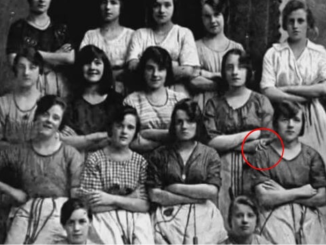Nature is full of fascinating and sometimes brutal adaptations, but few are as shocking as the birthing process of the spotted hyena. You might think childbirth is a universally painful experience, but hyenas take it to an entirely new level.
Female hyenas have one of the most unusual reproductive anatomies in the animal kingdom—what appears to be a penis is actually an elongated clitoris, known as a pseudo-penis. This rare adaptation makes mating, birth, and survival incredibly difficult for both mother and cubs.
Let’s dive into the science, struggles, and evolutionary mysteries behind why hyenas experience one of the most challenging births in the wild.
Hyenas’ Unique Reproductive Anatomy: A Bizarre Evolutionary Twist

The female spotted hyena (Crocuta crocuta) is unlike any other mammal when it comes to reproduction. Unlike most female mammals, hyenas have no external vaginal opening. Instead, their labia are fused together, forming a pseudo-scrotum, and their clitoris is elongated into what resembles a fully functional penis.
This means that both mating and giving birth happen through a narrow, tough, and inflexible canal—a structure that poses serious risks to both mother and cubs.
But why would evolution favor such an extreme adaptation? The answer lies in hyena social structure and dominance.
The Link Between Dominance and Reproductive Anatomy
Hyenas live in strict matriarchal societies, where females outrank males in dominance. The unusual reproductive anatomy is believed to be an evolutionary adaptation linked to social hierarchy.
- A Display of Strength: A larger pseudo-penis might act as a dominance signal, making it clear which females hold power in the clan.
- Hormonal Influence: Female hyenas have higher testosterone levels than males, leading to increased aggression and dominance over the pack.
- Mating Challenges: Males must earn the right to mate, as females control copulation with their complicated anatomy.
Video : Hyenas’ Brutal Birth: The Most Painful Labor in the Animal Kingdom
While this system gives females power, it comes at a terrible cost when it’s time to give birth.
Why Giving Birth Is So Dangerous for Hyenas
Imagine trying to push a newborn through a passage too small, too rigid, and highly prone to tearing. That’s exactly what female hyenas go through every time they give birth.
Here’s what makes hyena birth so deadly:
- A Super Tight Birth Canal
- The pseudo-penis acts as the only birth canal, but it is long, narrow, and lacks the elasticity of a normal vagina.
- This makes labor extremely difficult and painful, with a high chance of the tissue tearing.
- First-Time Mothers Face the Worst Risks
- Many first-time mothers do not survive the birthing process due to severe ruptures.
- Those who do survive often suffer from long-term damage to their reproductive organs.
- High Cub Mortality Rate
- A staggering 60% of hyena cubs suffocate before they are fully delivered.
- Since the birth canal is so tight, cubs often become trapped and die before they can emerge.
- A Painful Recovery Process
- After birth, the pseudo-penis often ruptures completely, forcing it to heal over time.
- Mothers suffer weeks of pain and vulnerability while their bodies recover.
Despite these brutal challenges, hyenas continue to thrive, and their unique reproductive system has remained largely unchanged for millions of years.
How Do Hyenas Mate? The Struggles of Reproduction

If you think birth is difficult for hyenas, mating is no easier. Males must overcome significant anatomical and social obstacles just to reproduce.
- Males Are Submissive to Females
- Unlike in many species where males dominate, male hyenas are the weaker sex in both power and ranking.
- They must approach females cautiously, often displaying submissive behavior to gain approval.
- Navigating the Pseudo-Penis
- Since females have no traditional vaginal opening, males must carefully maneuver through the pseudo-penis to copulate successfully.
- This requires both patience and precise positioning, making it one of the most complex mating processes in the animal world.
- Only the Strongest Males Get to Reproduce
- Males don’t fight each other for dominance like in other species. Instead, they must earn the female’s trust over time.
- Females choose mates based on persistence, patience, and respect, ensuring only the most determined males pass on their genes.

Given how dangerous and inefficient the reproductive process is for hyenas, one might wonder why evolution hasn’t corrected this issue.
The answer lies in survival strategy and social dynamics.
- Matriarchal Control Guarantees Stronger Cubs
- By limiting mating to only the most persistent males, female hyenas ensure that their cubs inherit strong genetics.
- This method prevents weaker genes from spreading, keeping the species robust.
- Higher Testosterone Helps With Survival
- The same high testosterone that makes birth difficult also makes female hyenas stronger and more aggressive.
- This aggression helps protect their cubs and maintain dominance in their environment.
- Fewer Cubs = More Resources
- Since many cubs don’t survive birth, the ones that do are often given more attention and resources.
- This ensures the strongest cubs make it to adulthood, increasing the clan’s overall survival rate.
The Resilience of the Spotted Hyena
Despite their brutal birthing process, hyenas have thrived for millions of years. Their ability to adapt, dominate, and survive proves just how powerful evolutionary trade-offs can be.
- They are among Africa’s most successful predators, competing with lions for food.
- Their clans are ruled by powerful females, ensuring only the strongest members survive.
- They have some of the most advanced social structures in the animal kingdom, making them highly intelligent and strategic.
Video : The Most Extreme Births In The Animal Kingdom
Conclusion: Nature’s Ultimate Test of Survival
Hyenas are proof that nature often prioritizes survival over comfort. Their unique reproductive anatomy, extreme birthing challenges, and dominance-driven society have allowed them to thrive despite overwhelming odds.
While their birth process remains one of the most painful and deadly in the animal kingdom, it also ensures that only the strongest females and cubs survive.
So the next time you see a spotted hyena, remember—they’re not just fierce scavengers. They’re survivors of one of evolution’s toughest reproductive challenges.
New alarming verdict on Prince George, Princess Charlotte, & Prince Louis amid Kate Middleton’s cancer diagnosis

With her public announcement of her cancer diagnosis, Catherine, Princess of Wales, put an end to the many theories and conjectures that had been making the rounds in the media ever since her scheduled abdominal surgery.
She stated in the video that tests performed by the doctors after her surgery revealed the malignancy. She went on to say that before telling the public, she and William needed some time to break the news to their kids.
Royal analysts surmise that Kate had a purpose in releasing the film on Friday at 6 p.m., as their kids’ school had already ended and they wouldn’t be confronted with inquiries about it right away from their peers.
A palace source told the Times, “George is ten now and can’t be shielded from any of this now.””He won’t be able to avoid it once it’s in the school playground and at the school gate.”

Grant Harrold, the former butler of King Charles, claims that when Kate and William informed the kids about her disease, they approached each child differently. He thinks that when they told Prince Louis about her health problems, the couple probably “sugarcoated” them.
Grant Harrold told the NY Post, “I’m sure it was a very difficult and very different conversation between children.””I’m sure the conversation with Louis was more sugarcoated than it was with George and Charlotte, for example.”
“The older children can understand more, so I’d imagine it was a little more frank but undoubtedly staying positive, which is so important,” the former butler went on.

This explains why you now cry when you see the photo of Kate with her three kids. It’s important for any mother to have that talk, and you can bet Charlotte and George will be there to support her.
Louis is too little to comprehend her mother’s situation, he continued.
It’s a challenging one. He told the NY Post, “I’m sure the kids will handle it as any kids would be expected to handle it, but I think that will rub off on the kids because their parents are very good at being calm and collected.”
The kids will spend Easter break with their parents at Anmer Hall on the Sandringham Estate, where they may go egg hunting and have fun.

Easter Sunday mass will probably be attended by King Charles and Queen Camilla, but not by the family.
Danielle Stacey, the royal expert for Hello! Magazine, stated, “It’s understood that King Charles may attend a church service on Easter Sunday with a smaller royal turnout if his health allows it.”
“As he continues his cancer treatment, Charles has minimized his contact with larger crowds to reduce risks,” the spokesperson added. “The King has performed for small audiences at Buckingham Palace, but he hasn’t gone to any major events since receiving the diagnosis, like the Commonwealth Day service, the Korean War Veterans’ reception last week, or the late King Constantine’s memorial in Windsor last month.”
About 110 miles outside of London is the Norfolk country estate known as Anmer Hall, where the Princess of Wales is believed to feel “most at home.”
She previously stated that she is happiest “outside in the countryside with my family.”
She would be creating Easter cakes with the kids, and they would be decorating them with Cadbury eggs.

Three years ago, it was said that the children surprised Queen Elizabeth and Prince Philip with “personalized Easter eggs, which they made and decorated themselves.”Grandpa Charles and Step-Grandmother Camilla will probably get one of them this year.
As previously indicated, their parents host an annual Easter egg hunt in which George, Charlotte, and Louis will participate.
“It was a real treat because they don’t let George, Charlotte, and Louis have chocolate and sweets every day,” the insider told Us Weekly.
In addition to playing tennis and going on family bike excursions, George and Charlotte also enjoy taking horseback riding lessons. Charlotte shares her great-grandmother’s obsession for horses. It’s her preferred pastime.

For Kate, spending time with her kids has always been a blessing.
“She constantly says that having her family around helps her get through tough times, and the kids always make her day happier. The Us Weekly source continued, “She feels incredibly fortunate to have her children and a wonderful family.
Thus far, Prince George has not experienced any negative effects from royal news. However, it’s possible that his mother’s illness will, regrettably, be his first introduction to the responsibilities of being a member of the royal family.
According to royal analyst Sarah Vine, Kate Middleton and William are “lucky” that their kids are still “quite young,” as it would be more difficult to keep them safe from finding out about their mother’s diagnosis online if they were older.
“It’s imperative to attempt to manage the kids because they will undoubtedly have a lot of questions and it’s just really scary knowing that your mother is ill,” she said.
“Plus, kids on the playground are cruel, so it’s better that it’s not exposed to the kids on the playground just yet,” co-host Andrew Pierce continued.



Leave a Reply